      |
16,3km hike in La Bastide-Puylaurent
|
      |
Exiting L'Etoile Park through the gate, turn left and cross the Allier River via the footbridge. Join the back of the church and follow the Regordane trail shared with the GR72, which ascends to the hamlet of Thort located on the watershed line. Next, pass by the Thort dolmen, also known as the Palet de Gargantua, and leave the GR trail markings to climb to the right towards the Croix de Grabio. Take the main-droite path just before the cross, which descends to Masmejean.
300 meters before the hamlet, by the Allier River after the small bridge, you'll find an ideal spot for a picnic. After Masmejean, the trail climbs towards the Moure de la Gardille. At the top of the plateau, turn right towards the Allier Valley and La Bastide-Puylaurent by following the Stevenson Trail GR70 and the shared GR7. As you descend, you'll be greeted with a spectacular view of the Ardeche mountains and the Notre Dame des Neiges Abbey in the distance.

4km - 11km - 11,2km - 14km - 15,5km - 16,3km - 19km - 21,5km - 23,2km - 24km
Google Maps
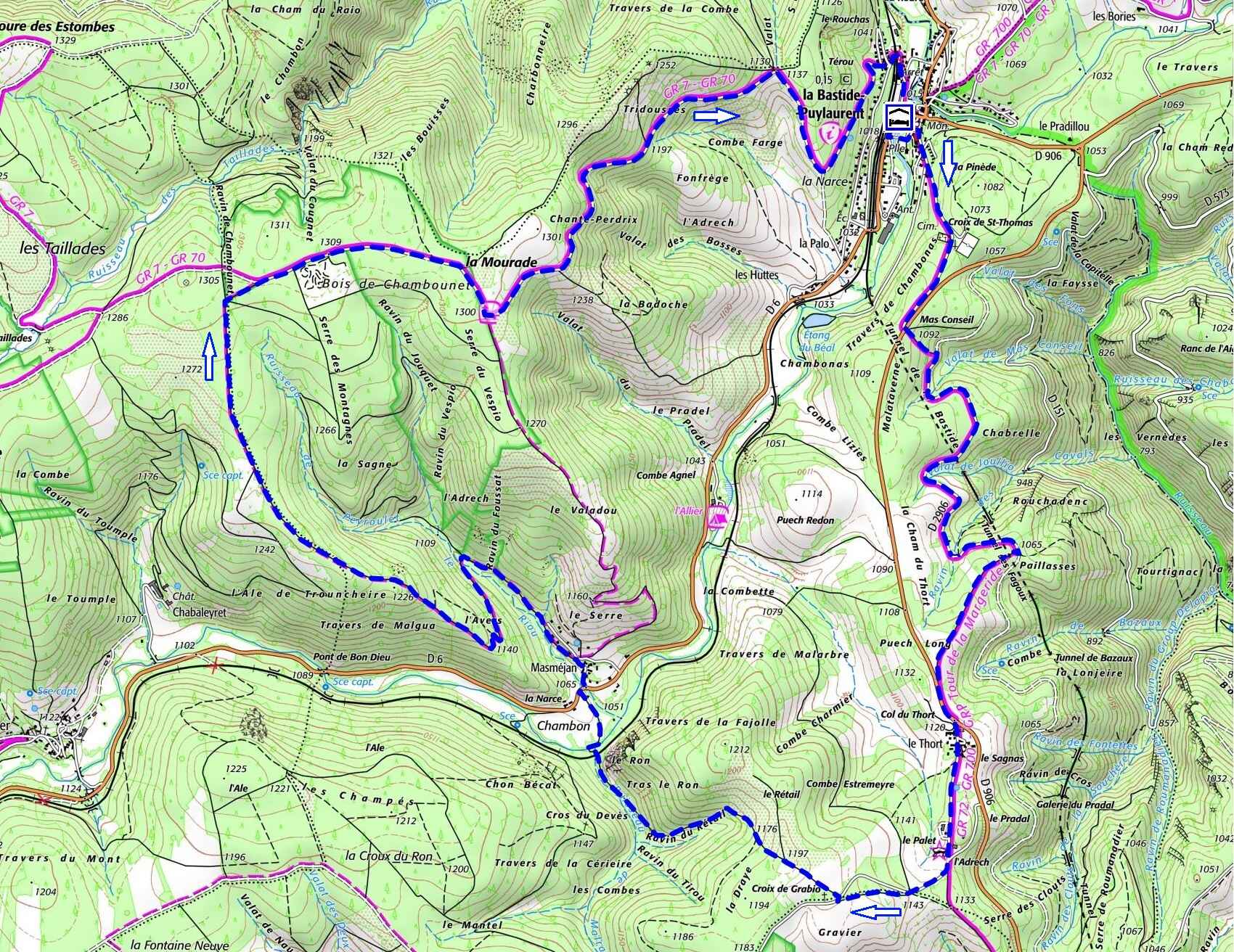

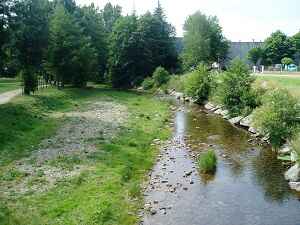
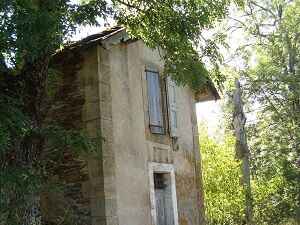
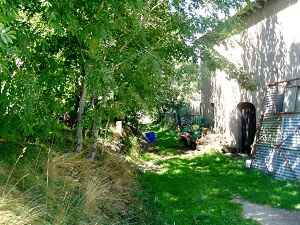
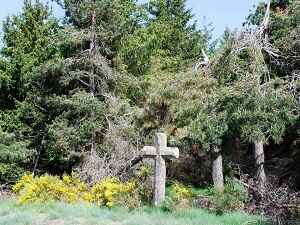
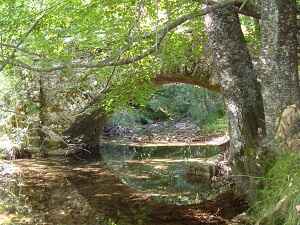

Distance: 16.3 km Maximum Elevation: 1,328 m Minimum Elevation: 1,014 m Total Ascent: 429 m
IGN Maps: La Bastide-Puylaurent (2738E), Largentiere La Bastide-Puylaurent Vivarais Cevenol (2838OT)
Print the hike
Mazon vividly describes the Cevennes muleteers and their equipment, revealing the picturesque and colourful aspect of their outfit and their crews. These mountaineers, often called "padgels", wore a red wool cap topped with a large felt hat with wide brims that could be adjusted according to the weather conditions. Their outfit was distinguished by bright colours: a loose jacket in white cadis, short breeches in green cadis, white gaiters decorated with red garters, a scarlet wool belt and a red tie. They also wore gold earrings, decorated with a mule iron, recalling their profession. The muleteers formed impressive convoys, or "coubles", where each mule, richly harnessed, carried heavy wineskins. The animals wore copper plates - or "phalerae" - on their heads, decorated with red pompoms and a high wool plume. During parades in the sun, these ornaments produced sparkling flashes, adding to the spectacular character of the whole. The muleteers came from villages in the Cevennes such as La Bastide-Puylaurent, La Garde-Guerin, Villefort and Saint-Laurent-les-Bains, embodying the spirit of the mountains in their dress and role.
The Regordane Way, of Celtic origin, has long linked La Bastide, Villefort and Langogne. Used since Antiquity, it ensured communication between Nîmes and Clermont and gained in economic and strategic importance with the Roman conquest in the 2nd century BC. This road facilitated trade, allowing the muleteers to transport products such as wine from the south and cheeses from the Massif Central. The Phoenicians also used it to travel to Great Britain in search of tin. From a strategic point of view, the Regordane ran along the eastern border of the Gabal region and was monitored by Caesar's Camp, near Langogne. It also played an important role during the conflicts between the Franks, Burgundy and the Visigoths of Spain in the 6th century. Over time, this road became a major axis, integrated into the Royal Route 106, then renamed the Imperial Route, National Route 106, and finally the Departmental Route 106. From 1835, work modified the route to smooth out certain difficult passages, notably between Saint-Laurent-les-Bains and the adjacent pass, then between the pass and La Bastide, creating the current route of the D4. Around 1880-1885, a diversion of the National Route 106 made it possible to avoid the climb of Thort, this section joining the D4 as it enters Lozere. More recently, the C.D. 906 was redeveloped to follow the historic route of the Regordane at the Thort, thus reconnecting with its ancestral course.
The Thort dolmen, also known as the "Palet de Gargantua", is a megalith located along the Regordane route, an ancient passageway linking the south of France to the Massif Central. This dolmen, emblematic of the region, is a fascinating testimony to the human presence and ancient cultural practices along this historic route. The Thort dolmen is formed of large upright stones that make up a burial chamber, topped with an imposing slab evoking a monumental table, which earned it the nickname "Palet de Gargantua". Local legends often associate these megaliths with giants, and the mythical character of Gargantua, popularized by Rabelais, is frequently invoked to explain these imposing structures. Here, the large slab is interpreted as a stone puck thrown by this legendary giant. The Thort dolmen probably dates back to the Neolithic period, around 5,000 years ago, a time when these monuments were often used as collective burials. Its position near the Via Regordane bears witness to the importance of this route for commercial and cultural exchanges over the centuries. This ancient route, linking Nîmes to Clermont, was already used by Neolithic populations well before the Roman occupation, as evidenced by archaeological remains. The "Palet de Gargantua" is fully integrated into the heritage and collective imagination of Lozere. The legend surrounding this dolmen has reinforced its attractiveness, making it a regional symbol and a site appreciated by visitors. At the crossroads of history and myth, the Thort dolmen embodies the richness of local traditions and the memory of an ancient human presence. Easily accessible to hikers and megalithic heritage enthusiasts, the Thort dolmen is one of the points of interest on the Regordane route. This site particularly attracts those interested in archaeology, the surrounding natural landscapes, as well as the legends of Gevaudan, offering a link between the past and the present in a unique setting.
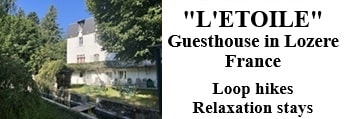
Former holiday hotel with a garden along the Allier, L'Etoile Guest House is located in La Bastide-Puylaurent between Lozere, Ardeche, and the Cevennes in the mountains of Southern France. At the crossroads of GR®7, GR®70 Stevenson Path, GR®72, GR®700 Regordane Way, GR®470 Allier River springs and gorges, GRP® Cevenol, Ardechoise Mountains, Margeride. Numerous loop trails for hiking and one-day biking excursions. Ideal for a relaxing and hiking getaway.
Copyright©etoile.fr









